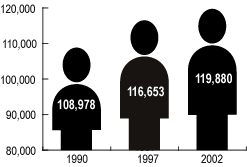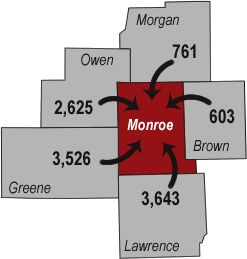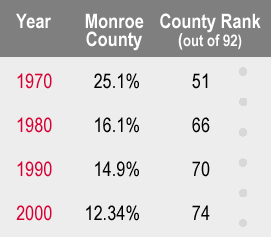Bloomington
President, Strategic Development Group, Inc., Bloomington
In many ways Bloomington is to Indiana what California is to the United States: the tenth most populous city in the state often serves as Indiana's harbinger. It appears that what is happening in this community might likely show us what is in store for Indiana.
Economically, this has been a rough year for the Bloomington Metropolitan Statistical Area (MSA). However, the community remains one of the economic leaders in the state. This is an economy that is in transition, but it is not clear what Bloomington's economy is moving toward.
Reviewing changes in population, employment and wealth provides a quick evaluation of Bloomington's overall economic health. In terms of population change, the Bloomington MSA continues to grow (see Figure 1). In recent years, its rate of growth has slowed somewhat from the previous twenty years, but the population is still growing. Bloomington's population growth rate between 1990 and 2000 is slightly above the state average.
Figure 1
Monroe County Population

In terms of employment, the community has shown a strong performance over
the past twelve months. The September 2002 unemployment rate for the Bloomington
MSA was 2.9 percent, in contrast with the state average of 4.6 percent. Bloomington
had the third lowest unemployment rate in the state.
With a residential labor force of 61,390 in 2001, the community is also important
to the economies of Greene, Owen, and Lawrence counties. This residential labor
force has remained stable. Bloomington continues to serve as a regional employment
center. Over 11,000 people commute to the community to work (see Figure
2).
Figure 2
Commuting Patterns, 2000

While employment has remained strong in Bloomington, the nature of that employment is changing. After years of expansion, manufacturing employment in the county has shrunk over the past several years (see Table 1).
Table 1
Percent of Manufacturing Employment

Manufacturing now represents a smaller part of the Monroe County employment base than it does in any metro area in Indiana.
A trend that Bloomington has been experiencing for the past four years continues. Earnings from manufacturing declined from $390 million in 1998 to $360 million in 1999. Bloomington experienced a net loss of approximately 2,400 manufacturing jobs in the past twelve months.
However, despite the substantial loss of manufacturing employment, Bloomington's economy has remained relatively stable. The community has partly compensated for the loss of manufacturing employment with the growth of service and government jobs. Government now accounts for approximately 25 percent of the employment base, and service sector jobs make up over 25 percent of the employment base in Monroe County. Wages from government in 2000 totaled approximately $665 million; this includes employment at Indiana University Bloomington. This is an increase of almost 5 percent from the previous year. Wages in the service sector saw a stronger growth of approximately 8 percent, with growth in the health, business services, and engineering subsectors.
Bloomington continues to be an economy in transition. The community remains a locus of manufacturing, but the growth in higher wage employment appears to be coming from the government and service sectors. It will be interesting to see if the Bloomington experience reveals a new approach to the Indiana economy: retain a core manufacturing base, but grow the overall economy through higher paying jobs in education and service.
Also in this Issue…
- Outlook for 2003
- The U.S. Economy
- The International Economy
- Financial Forecast
- Housing
- Indiana
- Anderson
- Bloomington
- Columbus
- Evansville
- Fort Wayne
- Gary
- Indianapolis
- Kokomo
- Lafayette
- Muncie
- New Albany
- Richmond
- South Bend/Mishawaka and Elkhart/Goshen
- Outlook Summary for 2003
- Return to Table of Contents



